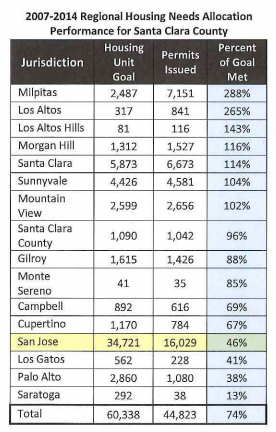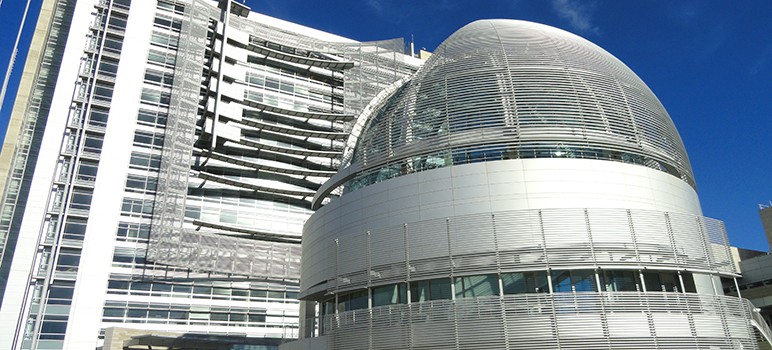In the last City Council meeting of the calendar year, San Jose officials will debate whether to commission a study on charging an affordable housing fee for commercial development.
Historically, affordable housing fees have been tied to residential development, requiring builders to either dedicate a portion of a complex to below market-rate units or pay in in-lieu fee.
Last year, the council adopted a $17-per-square-foot assessment for all new residential development of three or more units. But that fee doesn’t go into effect until summer 2016 and won’t generate revenue until 2018, per city staff reports. Once rolled out, the residential fee is expected to generate just $5 million a year initially and between $10 million and $20 million in 2020 and beyond.
A dearth of affordable housing funds matched by a historic surge in housing costs prompted city leaders to consider a similar fee for non-residential building. A commercial-linked assessment could bring in another $6 million to $14 million per annum, based on the average level of construction for the past six years.
Before implementing a new housing fee, however, the city has to study whether there’s a legal connection between new commercial development and the need for more affordable housing. The council on Tuesday will consider whether to commission a nexus and feasibility study.
A 2015 report by the National Housing Conference found that the San Jose metro area is the third-most expensive market in the nation. It’s also the second-priciest market for home ownership. Since 2010, San Jose has seen rents increase by more than 11 percent a year, according to RealFacts.
San Jose aims to set aside 60 percent of new homes for low-income families. But income-restricted housing requires public subsidies in the San Jose market, according to the city’s Housing director, Jacky Morales-Ferrand.
It should be noted that San Jose’s job growth and commercial development has lagged behind other cities in Silicon Valley. Santa Clara County has the strongest job market in the nation, but San Jose’s job base grew only 2.5 percent a year between 2010 and 2014, according to the city. That’s half the rate of the county overall.
While vacancy rates have declined, San Jose still has more empty office and retail space despite lower rents than neighboring cities. Since 2010, San Jose has gained the Samsung and Brocade headquarters in its commercial northside district, as well as new offices in Santana Row. The city also welcomed a new Bass Pro Shop, a couple new shopping centers, the Avaya Stadium and several small hotels.
“But, compared to its neighbors, San Jose has struggled to be competitive for new commercial construction, especially in the two largest categories regionally: office and R&D,” Morales-Ferrand wrote in a memo to the council.
Because the city has struggled to attract new commercial development, there’s a risk in enacting a new fee, she cautioned.
Mayor Sam Liccardo, Vice Mayor Rose Herrera and council members Chappie Jones and Manh Nguyen said the city should hold off on a local study in favor a regional solution.

Source: Office of Councilman Don Rocha
“With regard to affordable housing, we need to recognize that two assertions can be equally true: First, we've made several unprecedented efforts to produce more affordable housing, and to advocate for state legislation to enable us to do so,” they wrote in a shared memo. “Not the least of our efforts include becoming the largest city in the U.S. with a citywide inclusionary and impact fees on residential developers, forging legal battles that have taken us to the steps of the Supreme Court. At the same time, we can do everything ‘right’ on affordable housing, and still fall woefully short of our community's needs, given the much larger forces of supply and demand that shape this outcome.”
Councilman Don Rocha said it's disheartening that his colleagues want to postpone the matter until San Jose's jobs-to-housing ratio changes. In a separate memo, he said that the city should also look at a regional solution, but stressed that the there's a moral obligation to act quickly because so many residents are grappling with high housing costs and homelessness.
“It's especially important that we act now, because there is an opportunity for regional leadership on this issue,” he wrote in a memo co-signed by council members Ash Kalra, Raul Peralez and Magdalena Carrasco. “Most of the other cities in the county have either already implemented a commercial impact fee, or are joining the countywide nexus study lead by the [Silicon Valley] Community Foundation. This interest in fees seems to be indicative of an increasing willingness across the county to support housing.”
It’s well documented that Santa Clara County is experiencing homelessness at record highs. This region’s housing costs...
Posted by Donald Rocha on Monday, December 14, 2015
More from the San Jose City Council agenda for December 15, 2015:
- After the Mercury News reported how San Jose’s elected leaders routinely failed to report meetings with lobbyists, the city may create an electronic filing system. As part of a broader revision to the city’s ethics rules, Councilman Johnny Khamis suggested holding nonprofit lobbyists to the same transparency standards as their private and governmental peers. “In order for the public to be aware of organized, government-funded groups that seek to influence the city’s elected officials, the requirements that apply to lobbyists must be extended to them,” he said. “If we are truly interested in openness, transparency and accountability, we need to see the records of ALL significant influencers, not just lobbyists. We cannot in good conscience continue to exempt some groups that directly benefit from their interactions with government. We need to have our eyes wide open to this reality and respond accordingly.”
- Up for consideration: a permit to build a master-planned apartment-retail development. The 403-unit complex will sit on the corner of North 10th and East Taylor streets and include 5,000 square feet of retail space.
- Mayor Liccardo’s annual salary may go from $114,000 to $125,000 while each council member’s will increase from $81,000 to $92,000.
- The state Legislature approved a resolution to dedicate a portion of Highway 87 as a memorial to an officer killed in the line of duty this past March. The San Jose Police Department will pay $6,000 to erect a sign designating the roadway as the “San Jose Police Officer Michael Johnson Memorial Highway.” The 9-by-4-foot sign will go up on the northbound Capitol Expressway offramp.
- The Mineta San Jose International Airport may waive a marketing fee to lure new airlines to San Jose. The direct fiscal returns outweigh the cost, according to a report signed by Mayor Liccardo and council members Jones, Carrasco, Peralez and Khamis. “By itself, those returns justify the investment,” they wrote. “However, when one considers the total economic return from that investment—in new jobs, revenues to restaurants, hotels and taxis, and tax revenue to the city—it becomes all the more apparent that ‘you need to spend money to make money.’”
- Several residents and nonprofits wrote letters urging the city to establish urban agriculture zones. The land designation piggybacks off of a relatively new state law that gives property owners tax breaks for using brownfields as urban farms—like the Taylor Street farm run by nonprofit Garden to Table.
- Council members have nominated new policy proposals to a priority list. Among the nominees are policies to address the gender wage gap, establish urban ag zones, putting license plate scanners on garbage trucks and allowing electronic billboards.
WHAT: City Council meets
WHEN: 1:30pm
WHERE: City Hall, 200 E. Santa Clara St., San Jose
INFO: City Clerk, 408.535.1260
This article has been updated.


The only way to make money in San Jose Politics is not to go down to the Cafeteria and steal from the lunch register, its to set up real estate scams like the San Jose Redevelopment Agency and to put in power Hispanics like the Mayor and Vice Mayor and other key Hispanics in power. When they try to seize more than there share they are sent to Public works. You have a Mexican Political Cartel in San Jose.
Why stop at commercial development? I can think of lots of unrelated busnissess that can be sheared like sheep for this feel-good nonsense. Let’s tax trucking, and grocery stores, and… &etc.
The problem is that these new ‘fees’ end up costing everyone, and they aren’t intended to really solve anything: the pols, bureaucrats, and their pals will get their cut, and some crumbs will fall off the table for the “homeless”. And these programs never end; they’re permanent employment for a few favored pals.
How about cutting taxes for once? If these jamokes had ever read Bastiat’s Broken Window Fallacy, they would know that reducing taxes is the best way to make the city wealthier.
But they don’t really care about the city, do they?
When are the Mayor and council going to put creating a funding plan for fully staffing SJPD on their priority list? Mayor Liccardo has no sense of priority if he thinks residents need urban agriculture zones before cops.
Well if we are going to charge more for people to build a business or build housing here= a new tax, shouldn’t we offer
a tax rebate for people or businesses to leave ?
If we sell our homes the city gets a big new tax increase, For example if you sell a house that is being taxed at $500,000 is sold for a million the benefit the the county is +$7500 the first year.
Chasing people out of town would be a big financial gain for the city, and greedy rich people can be sent on their selfish way.
Lets get rid of the rich and move in the poor and charge the more to do that. Worked in Detroit!
Jack Slade is an idiot. I bet he smells bad too.
Does anyone actually believe this is a good idea? Why not just call it like it is: a special interest slush fund. If you really wanted to help fight homelessness, let’s open a ranch in south San Jose where homeless can sleep in a dorm room, take showers, get drug and psychological treatment, and learn some job skills. Instead, this money will be handed out (in the form of housing subsidies) to people that are most politically connected to the gravy, (i.e. They hear about the programs soonest) or have implausible numbers of children relative to income (their “needs ratios” look the most severe).